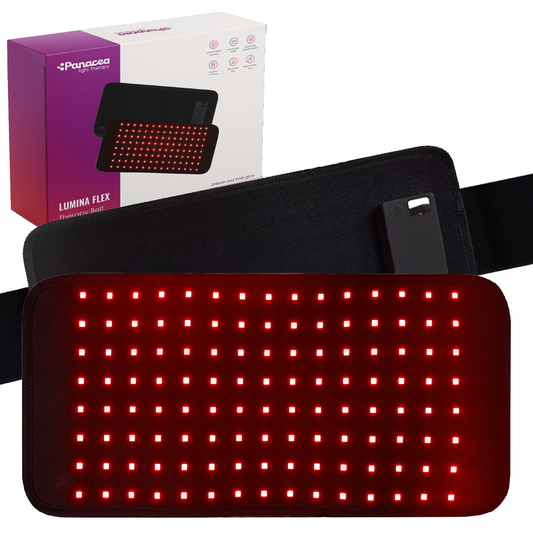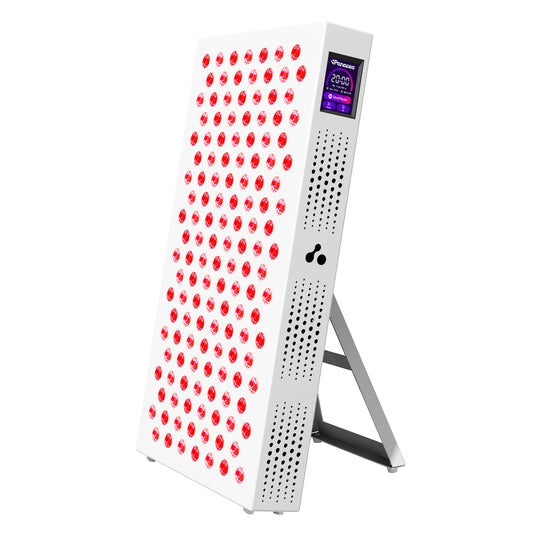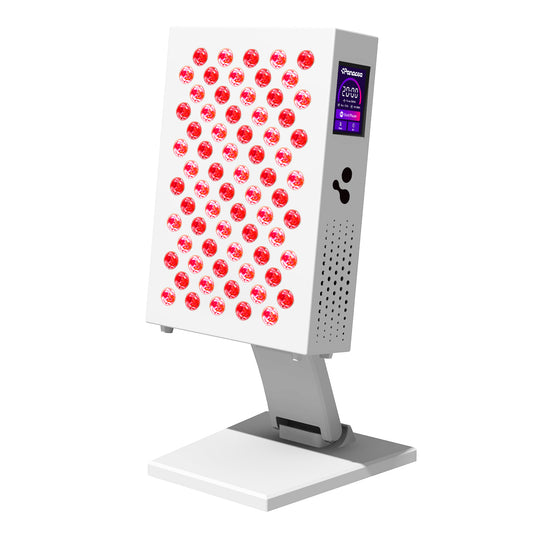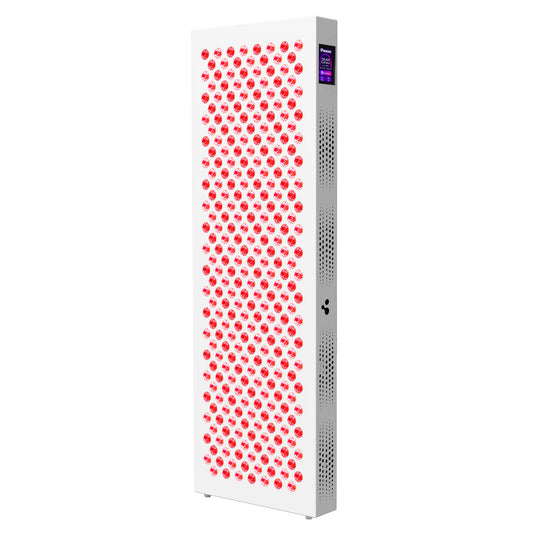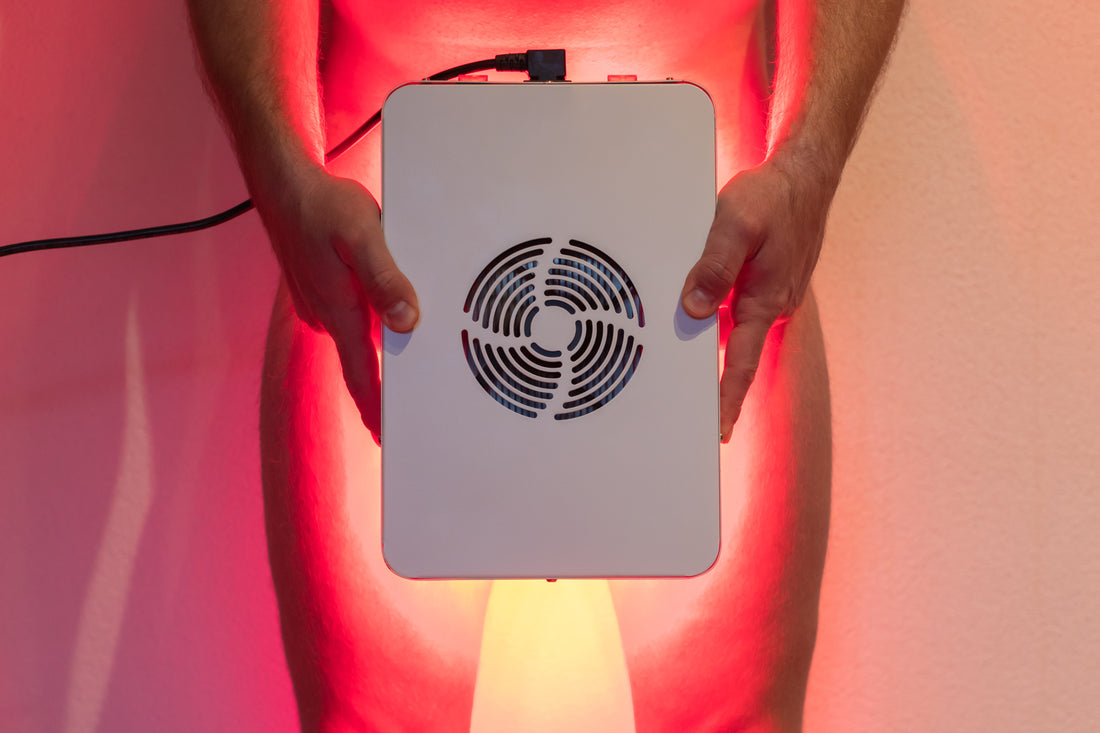
Red Light Therapy: A Promising Way to Boost Your Testosterone Levels
Increasing testosterone (T-levels) is a hot topic among men looking to improve their physical performance, address fertility issues, or simply optimize their overall health. Testosterone, the primary male sex hormone, plays a crucial role in muscle growth, energy levels, and even mood. A lesser-known, yet promising method of boosting natural testosterone production is red light therapy. In this blog, we’ll take a closer look at how red light therapy works, the scientific research that supports it, and how you can use this therapy to increase your testosterone production.
What is Red Light Therapy?
Red light therapy, also known as photobiomodulation, is a form of light therapy that uses specific wavelengths of red and near-infrared light. These wavelengths (660 nm for red light and 850 nm for near-infrared light) penetrate deep into the skin and underlying tissues. They have a direct effect on the mitochondria, the powerhouses of our cells. By increasing the production of ATP (adenosine triphosphate), red light therapy improves cellular energy production, reduces inflammation, and supports repair processes in the body. These effects are crucial for optimizing hormonal balance, including testosterone production.
How Does Red Light Therapy Increase Testosterone Production?
The effect of red light therapy on testosterone production is a subject of growing scientific research. Here are some mechanisms that suggest how red light may increase testosterone production:
- Improved Mitochondrial Function: Red light therapy stimulates the mitochondria in Leydig cells in the testes, which can lead to increased testosterone production. These cells are responsible for testosterone production, and by improving their function, overall testosterone production can be increased.
- Reduced Inflammation: The anti-inflammatory properties of red light therapy improve hormonal balance. This is beneficial for testosterone production, as chronic inflammation can inhibit this production.
- Stimulation of Blood Circulation: Red light therapy promotes better blood circulation, allowing more nutrients and oxygen to reach the testes. This supports the health and functionality of the Leydig cells, which in turn can increase testosterone production.
Which Wavelengths are Most Effective?
Red light therapy is most effective at specific wavelengths in the red and near-infrared spectrum:
- 600-650 nm (Red light): These wavelengths penetrate into superficial layers and are effective in stimulating mitochondria in the testes.
- 800-850 nm (Near Infrared Light): This range penetrates deeper into tissue and is particularly effective in stimulating Leydig cells for increased testosterone production.
- 900-1000 nm (Near infrared light): Higher near infrared wavelengths can reach deeper tissues, contributing to hormonal stimulation.
These wavelengths correspond to the absorption peaks of cytochrome c oxidase in the mitochondria, leading to increased energy production and ultimately higher testosterone production.
Scientific Studies on Red Light Therapy and Testosterone
There are several studies that have examined the relationship between red light therapy and testosterone production:
- 2013 study by TL Andersen and colleagues: This study showed that daily exposure of the testes to red light for 30 minutes per day for 14 days led to a significant increase in testosterone levels in male subjects. The researchers concluded that red light therapy could be a promising method to stimulate natural testosterone production.
- Study published in the journal "Lasers in Surgery and Medicine" : This study investigated the effects of red and infrared light on mitochondrial activity in Leydig cells. The results showed that exposure to light with a wavelength of 600-1000 nm caused an increase in cellular energy production and improved testosterone production.
- Clinical trial conducted in 2016 : This trial investigated the effect of red light therapy on athletes, with increased testosterone levels and improved muscle recovery capacity observed after regular use of the therapy.
How to Use Red Light Therapy for Optimal Testosterone Production?
If you're considering using red light therapy to increase your testosterone production, there are some important points to keep in mind:
- Duration and Frequency: Studies show that daily exposure of 10-20 minutes to red light can be effective. Total exposure time per session and frequency per week may vary depending on individual goals and responses.
- Targeted Application: For best results, it is recommended to apply red light therapy directly to the lower abdomen or groin area, close to the testes, where testosterone production takes place.
- Choose the Right Device: Make sure you use a device that emits the correct wavelengths (600-1000 nm) and has a high enough intensity to penetrate deep into the tissues.
Red Light Therapy and Strength Training: A Winning Combination
Strength training is another proven way to increase testosterone levels. Combining strength training with red light therapy can have synergistic effects. Applying red light therapy after a workout can speed up recovery and enhance the natural peak in testosterone production after exercise.
Other Natural Methods to Increase Testosterone
Besides red light therapy, there are several other natural ways to optimize your testosterone levels:
- Nutrition : Eating foods rich in zinc, vitamin D, and healthy fats can support testosterone production.
- Sleep : Getting enough sleep is crucial for hormonal balance and healthy testosterone production.
- Stress Management : Chronic stress increases cortisol, which can suppress testosterone. Mindfulness and relaxation techniques can help reduce stress.
Conclusion: Red Light Therapy as a Natural Testosterone Booster
Red light therapy offers a promising, natural approach to increasing testosterone production, especially when combined with other healthy lifestyle habits like strength training and a balanced diet. While further research is needed to fully understand its effects, existing studies indicate significant benefits, especially for men looking to improve their physical performance or optimize their fertility. Consider incorporating red light therapy into your daily routine and discover how it can help you boost your testosterone levels and improve your overall well-being.
More information about Red Light Therapy and Testosterone:
- https://www.nih.gov/news-events/nih-research-matters/understanding-how-testosterone-affects-men
- https://www.health.harvard.edu/medications/testosterone--what-it-does-and-doesnt-do
- https://www.nih.gov/news-events/nih-research-matters/understanding-how-testosterone-affects-men
- European College of Neuropsychopharmacology (ECNP). “Lack of interest in sex successfully treated by exposure to bright light.” ScienceDaily. ScienceDaily, September 18, 2016.
https://www.sciencedaily.com/releases/2016/09/160918214443.htm - Golan, Ron et al. “Age-related testosterone decline is due to decline of both testicular and hypothalamic-pituitary function.” https://www.ncbi.nlm.nih.gov/pmc/articles/PMC4816459/
- Stanworth, Roger D, and T Hugh Jones. “Testosterone for the aging male; current evidence and recommended practice.” Clinical interventions in aging vol. 3.1 (2008): 25-44. doi:10.2147/cia.s190, https://www.ncbi.nlm.nih.gov/pmc/articles/PMC2544367/
- Jeng, Hueiwang Anna. “Exposure to endocrine disrupting chemicals and male reproductive health.” Frontiers in public health vol. 2 55. 5 Jun. 2014, https://www.ncbi.nlm.nih.gov/pmc/articles/PMC4046332/
- Vladimirovich Moskvin S., Ivanovich Apolikhin O. Effectiveness of low level laser therapy for treating male infertility. Biomedicine (Taipei). June 2018; 8(2):7, https://www.ncbi.nlm.nih.gov/pmc/articles/PMC5992952/
- Ban Frangez H., Frangez I., Verdenik I., Jansa V., Virant Klun I. Photobiomodulation with light-emitting diodes improves sperm motility in men with asthenozoospermia. Laser in Medical Science, 2015 Jan;30(1):235-40., https://pubmed. ncbi.nlm.nih.gov/25204851/
- Salman Yazdi, R., Bakhshi, S., Jannat Alipoor, F. et al. Effect of 830-nm diode laser irradiation on human sperm motility. Lasers Med Sci. (2014) 29: 97, https://pubmed.ncbi.nlm.nih.gov/23407899/

